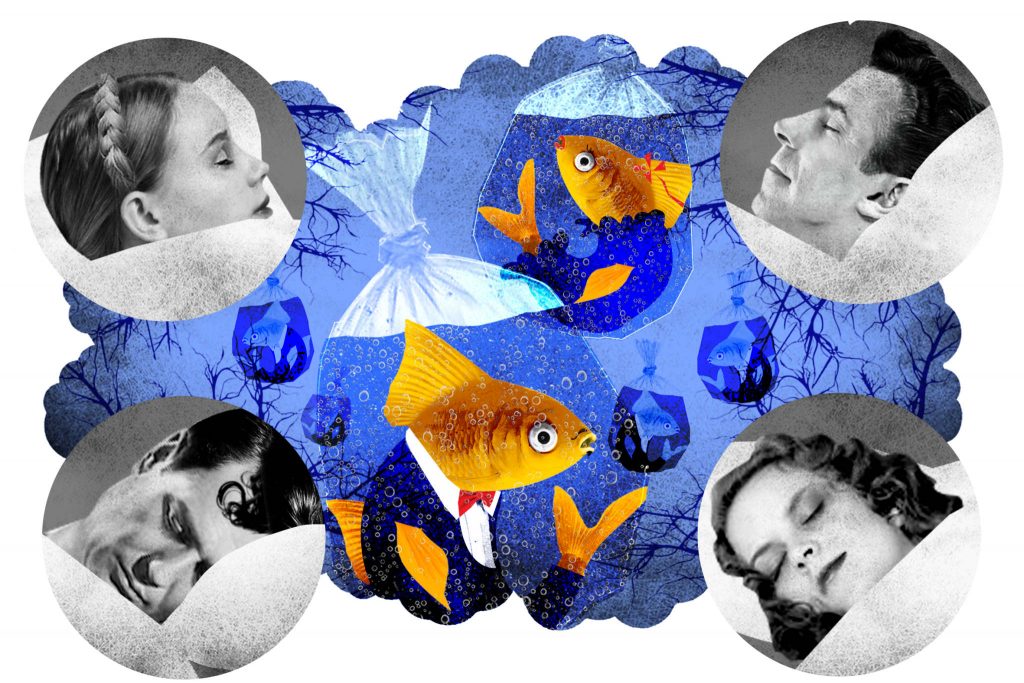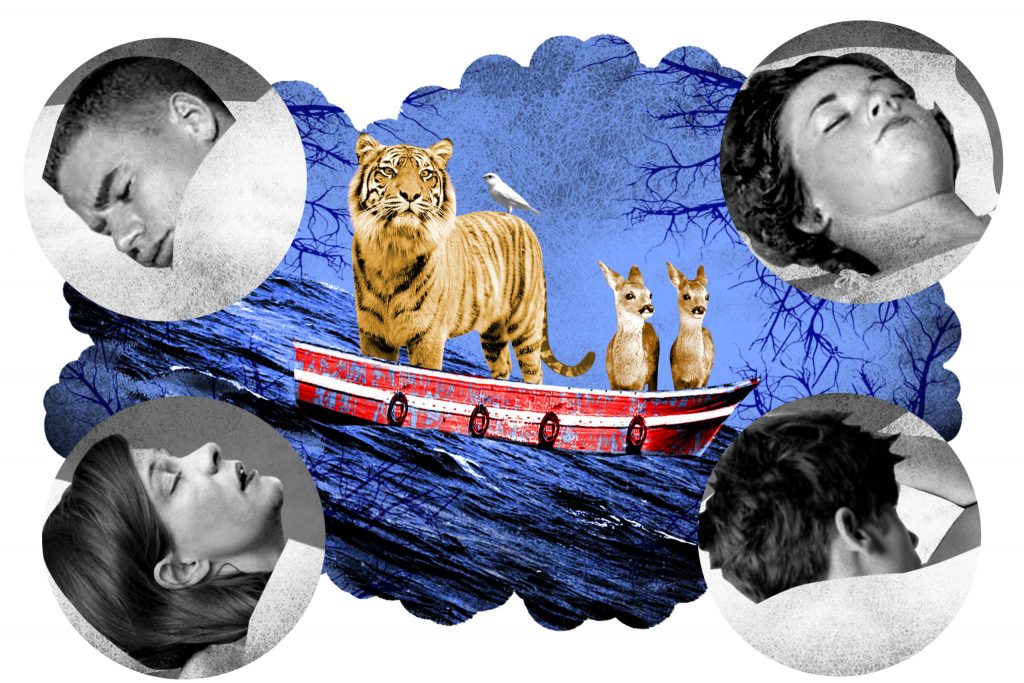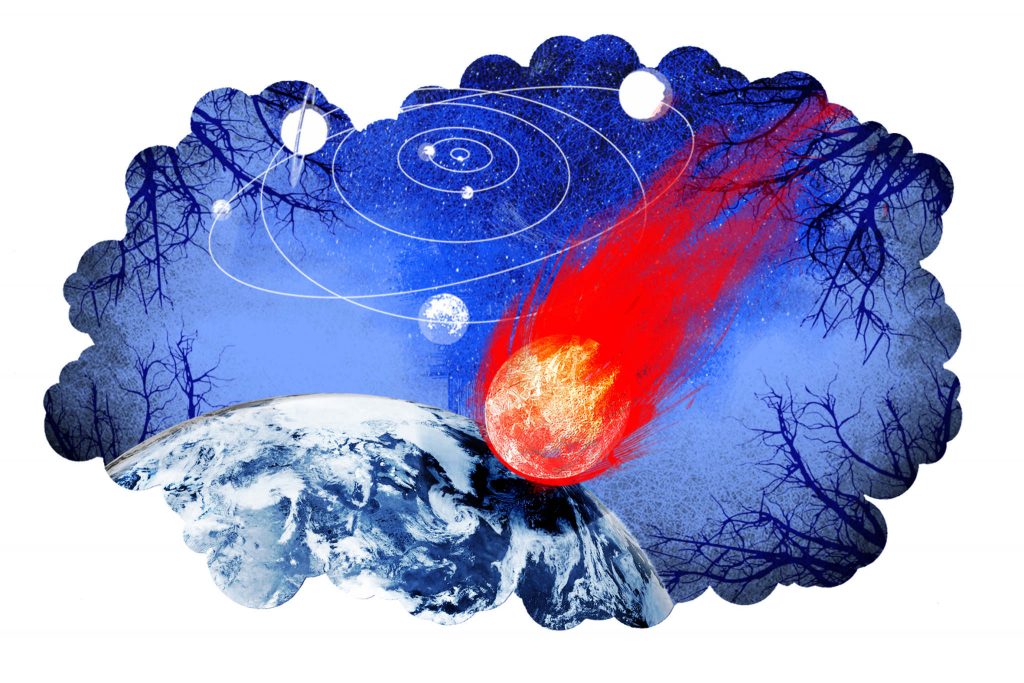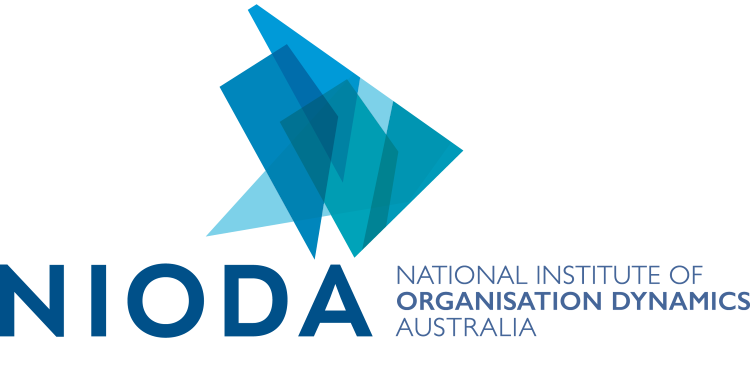
ILLUSTRATION: DIONNE GAIN
‘An unexplored continent’: What can dreams tell us about society?
This article: ‘An unexplored continent’: What can was originally published in the Sydney Morning Herald, June 5 2020, by Felicity Lewis: https://www.smh.com.au/national/an-unexplored-continent-what-can-dreams-tell-us-about-society-20200604-p54zcs.html
Many of us have had vivid dreams during this pandemic. What are we dreaming about? What subterranean zeitgeists might they reveal? And what is the point of knowing?
It was January in the northern Italian city of Turin and Franca Fubini, a psychotherapist and organisational consultant, was unsettled. She had been engaged in a long-running project where people share their dreams – a practice called social dreaming. But this group had spoken of nightmares: an asteroid hurtling towards Earth; a truck falling from the sky; people jumping from the balconies of a skyscraper …
“In January we didn’t know yet,” says Fubini of the coronavirus pandemic. “It was moving in the Far East, it would not touch us. But the dreams were all talking of losing control, of unexpected disaster of major magnitude.”
By February, when the Italian government had declared a state of emergency, the social dreaming group was a different mix of people but “that thread, which started to be woven [in January], was there”, says Fubini.
In the following months, with Italy in lockdown and COVID-19 sweeping the country’s north, other dream themes emerged: genetically modified insects, alien attacks, disconnected body parts, locked-up eyes and legs, dreamers unable to recognise themselves in mirrors – white-haired or unkempt, all dressed up but in ill-fitting clothes.
“They take a life of their own,” says Fubini of the dreams, “and we are no longer in control, [in the same way that] we are not during the pandemic.”
Since ancient times, cultures have tuned into dreams as messages from the gods, nature or their souls; since last century, dreams have been viewed as a coded language of the psyche; and today, some doctors, scientists and citizens also collect people’s dreams as data on, among other things, how we share responses to significant events and widespread crises such as this pandemic.
Trump dreams are a genre. Brexit dreams have been documented. And, in recent months, COVID dreams have become virtual-watercooler fodder. You only have to look on Twitter to see a sample of postcards from the land of nod (#CovidDreams), or you can add your own to citizen dream collection project idreamofcovid.com.
What does it all mean? How is dreaming a social activity? What glimpses of subterranean zeitgeists might a group’s dreams offer? And what would be the point of knowing?

ILLUSTRATION: DIONNE GAIN
What is social dreaming?
It’s a Sunday evening in Australia and 65 (mostly) strangers from Europe, South Africa, the US and Asia are gazing out of their little square computer screens for a meeting on Zoom. After a brief introduction, participants turn off their video cameras. There is a sea of black squares. “The matrix is now open,” says a woman’s voice. “And what will be the first dream?”
In the dystopian science-fiction film The Matrix, humans unwittingly exist in a simulated reality. In this matrix, humans are well aware they may be in the dark about the desires and impulses that move cultures and the systems in which they operate – but, through creating a network of associations about one another’s dreams, they can start to see a bigger picture.
One social dreaming expert likens this network to mycelium, the delicate filaments that underpin fungi and transmit nutrients and information across vast forests. Another adds that “we’re talking about deep, subterranean, murky, in-the-mud sort of stuff.”
What will be revealed tonight?
Over the course of this hour-long matrix, the Roosevelts appear twice (New Deal or new normal?); a dreamer is annoyed to discover she is married to pop singer Ed Sheeran (intimacy can be problematic during a lockdown); another dreamer is in the ocean trapped in a plastic bag full of water (a bit like a goldfish for sale, a bit like all of us during this pandemic, blinking out from our self-contained little worlds).
One of these goldfish is Mannie Sher, an executive coach and change consultant with the Tavistock Institute of Human Relations. The London institute has been at the cutting edge of research into group dynamics since World War II when it helped the British Army improve relations between officers and soldiers in the lower ranks. Central to its thinking is that a group, as well as an individual, has a life of its own.
“Social dreaming is like a megaphone from another world and we ought to listen to it,” says Sher. “It’s not miraculous, it’s not mysterious. The unconscious is an unexplored continent and there are links and connections that float around, looking for dreamers.”
Sher, who trained as a social scientist and psychotherapist, has used social dreaming as “a diagnostic tool” for years, including in boardrooms and at conferences to loosen minds – after all, the focus is on the dreams and not the dreamers.
“If the matrix is run skilfully, you’ll find that it’s not just the dreaming that gets freed up … the organisation too somehow gets freed up to think new thoughts. And that’s what we’re after.”
Now he and colleagues in social dreaming around the world, including in the Social Dreaming International Network, are watching for patterns in dream matrices as this pandemic makes “social trauma” a “global trait”.
At first blush, the dreams and the associations from matrices run by the Tavistock Institute read as a jumble of signs and symbols: tigers and Tiger Kings; an exploding Brooklyn Bridge and every fifth person evacuated from Manhattan Island; a lieutenant on the Western Front with “Trump-like red hair that looks fake”, and, in June, a house that looks beautiful on the outside but has no “bone structure” within – just a rear room wall-papered all over with the face of George Floyd, the man whose death at the hands of police has sparked riots across the United States.
Over time, the dreams begin to kaleidoscope into a chronicle of the milieu in which they were dreamt. “Dreams can mean many, many things,” says Sher, and in social dreaming, a group’s free associations about the dreams are as important as the dreams themselves. “What we’re looking for is the drift. What direction is it going? What’s emerging out of the associations – rather than saying ‘your dream means this or that’.
“People don’t come to social dreaming because they’re having bad dreams or difficult lives,” he says. “They’re invited to join what you might call a social experiment – namely, what are our dreams able to tell us about the society we’re in?”

ILLUSTRATION: DIONNE GAIN
So, what are our dreams able to tell us about the society we’re in?
This was the question for Scottish sociologist, organisational consultant and educator Gordon Lawrence when he developed social dreaming as a tool of organisational dynamics in the early ’80s after reading the work of Jewish journalist Charlotte Beradt, whose book The Third Reich of Dreams made his “skin tingle”.
Beradt covertly collected 300 dreams from Berliners from 1933, when the Nazis came to power, until she fled Europe in 1939, and details some of them in her book. A factory owner, for example, dreams he is visited by propaganda minister Joseph Goebbels; as he lifts his arm in the Nazi salute, his back breaks. Another man sees only rectangles, triangles and octagons in his dreams because dreaming itself is “forbidden”.
It was not personal issues that fuelled these dreams, Beradt contends, so much as “conflicts into which these people had been driven by a public realm in which half-truths, vague notions and a combination of fact, rumour and conjecture had produced a general feeling of uncertainty and unrest”. The dreams, collected before war had broken out, offered the warning “that totalitarian tendencies must be recognised before they become overt”. Beradt’s book, now out of print, has quite possibly been referenced more in the past few months in discussing COVID dreams than at any time since it was first published in the 60s.
Both Fubini and Sher worked with Lawrence. Over the years, Sher and his colleagues have collected dreams during a range of major events: from tent dwellers during the London Occupy Movement (“murder, cutting up bodies, rotting bodies – awful stuff”); at public sessions in a library during Brexit (“parents divorcing, chaos, the piling up of rubbish”) and after the election of Donald Trump (“triumph of the win, not binding together, insulting a woman”).
But while the pandemic has focused attention on dreaming en masse, dreams can also shed light on smaller group dynamics – including in the workplace.

ILLUSTRATION: DIONNE GAIN
What happens when you take dreams to work?
Dame Ruth Silver had been the principal of Lewisham College, in London’s south-east, for several years when she offered social dreaming sessions to staff at the start and end of each term. A trained psychologist (twice honoured for her services to further education), she regards dreams as data that offer “the opportunity, among other things, to construct an agenda for change”.
“The challenge for me, as the principal, was to say, ‘How do I keep on supporting the staff to be creative in raising students’ success?’”, says Silver. “We had dreams of … lost staff looking for students, students looking for staff, people not getting the right textbooks.
“There was a whole system of dreams that talked about, actually, we need to do more, forward. There were also things going on in society – black kids getting beaten up, the Stephen Lawrence murder [in south-east London in 1993]. What we were doing was terrific curriculum learning but actually it didn’t help them deal with the issues in their housing estates so colleagues encouraged and legitimised social justice work from students, not just to them.
“So it’s how the dreams are made meaning of by the institution – and that wasn’t for me alone to do, it was for all of us, saying, ‘What do you think that’s about?’ and, ‘If it is about that, what could we try?’ So, to authorise teachers to be free experimenters, not just experts.”
After the dream conversations, the college set up a sector first: a “quality unit” with a data analyst, researcher and head of learning and development for all staff. Out of that came a confidential teacher’s help desk that was “off system” so staff could flag issues without fear of their appraisals being affected. “They had a place to go that was for increasing and sharing their expertise because that helped the students,” says Silver. “We prototyped a lot of new structures that are still around.”
Silver, who now runs a think tank and sits on the board of the Jamie Oliver Foundation, has advised prime ministers on further education but stopped short of conducting a dream matrix at No. 10. “[Tony] Blair had a curiosity about it but he didn’t manage to do it,” she laughs.

ILLUSTRATION: DIONNE GAIN
What’s next?
It seems the US riots are now looming in our nocturnal visions. And dreams of (second) waves, and of nature, are emerging in local and international social dreaming matrices, says Susan Long, research director of the National Institute of Organisation Dynamics. Whether in Italy, Israel, England or the US, says Long (who also co-edited Social Dreaming: Philosophy, Research, Theory and Practice), group’s dreams are showing that they have not forgotten the plight of the natural environment even as the pandemic has eclipsed talk of it.
If dreams can act as stealthy reminders of our abiding concerns, Long also contends they can be “memoirs of the future” – not in a psychic way but in the sense that they help us to imagine what’s next. “In our daily lives we constantly anticipate what we will do in the future, whether in the next hour or the next year,” she says. “Our dreams do this also but they do it from an unconscious level. Social dreaming brings together the unconscious anticipations of all the participants and allows thoughts that we individually would not dare to think in our waking lives because they seem weird, risky or dangerous – but are there in the back of our minds.
“The associations of others turn the oblique and dissociated ideas in the dreams into comprehensible narratives, linked to everyday experiences.”
In London, Sher says talking about dreaming together enables new things to happen, even if, in organisations, these are mostly in the form of “baby steps”.
But it seems that making sense of our COVID dreams, or of any dreams for that matter, will take time; there’s a slow-burn aspect to the epiphanies they offer.
“You go to a matrix, you hear these dreams, and you can’t make sense of them,” says Sher. “That’s a state of mind that you have to accept, that sometimes you just don’t know what’s happening. Later on, you may find out, oh, we did know something – but we refused to acknowledge it.”
